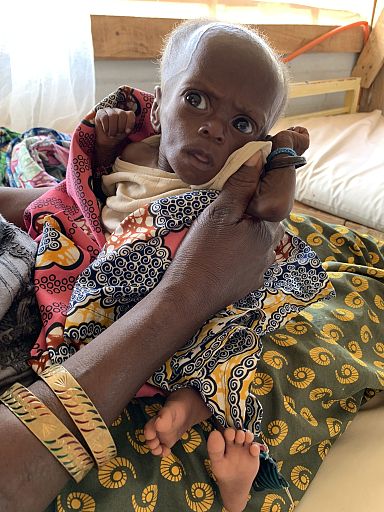38,000 children under the age of five-years-old are estimated to die every year from causes linked to malnutrition
- Almost 1.2 million people are food insecure in Niger
- It’s estimated over 380,000 children suffer from severe acute malnutrition
- 38,000 children under the age of five-years-old are estimated to die every year from causes linked to malnutrition
Chiya Habou is a small village in Zinder- the region with the highest rate of Global Acute Malnutrition in the whole of Niger. In this area, over 19% of children aged between six months and five years old suffer either from severe acute malnutrition or from moderate malnutrition (the World Health Organization crisis threshold is 15%).
In Chiya Habou, mothers are trained to screen their children by MUAC (the Middle Upper Arm Circumference) as a way of early diagnosis of severe acute malnutrition.
Euronews spoke to mothers using MUAC about their experiences with the technique.
"It's very useful because I use MUAC every week to check how my child is doing."
"I started with my second child when she was diagnosed with moderate acute malnutrition."
The NGO ALIMA started the project in the Mirriah district six years ago. Since that time, the idea of shifting diagnosis from a strictly hospital-based approach to a decentralized method has come a long way, at least according to ALIMA medical coordinator Ahmad AG Mohamed.
"In Niger, we have trained around one million and 650,000 mothers. 540,000 are in the district of Mirriah. The main advantage is the early diagnosis, which prevents hospitalizations."
"Of my 8 children, 3 have suffered from malnutrition," says mother Rouma Hakilou
In the village, a woman called Rouma has been using MUAC for years on her baby daughter, Sharifa. The 1-year-old suffers from moderate acute malnutrition and Rouma measures her often to avert her from falling into severe acute malnutrition.
"We have a field but the harvest is not enough to cover our food needs, so we have to purchase food, but the money is not enough either. Among my eight children, three have suffered from malnutrition" said Rouma Hakilou.
Every two weeks, Rouma walks 12 kilometres to the Gafati Health Centre. It is a place where children with malnutrition like her daughter receive specific food supplies and are monitored for 8 to 12 weeks. Mothers' screenings have increased the number of moderate acute malnutrition cases referred to local health centres like this one.
"The number of severe acute malnutrition cases in the first six months of the year has decreased by 13% compared to the same period last year," said one ALIMA Medical Coordinator.
Mothers' screenings have not had any impact at the national level so far.
Euronews travelled to the region's capital Zinder and discovered that the number of severely malnourished children at the national hospital has not significantly changed in the past years. Head Nurse, Hawaou Ousmane - who works at the Zinder Hospital - says between 8,000 and 9,000 cases of severely malnourished children are registered per year.
"The worst month is September with around 1,200 cases."
Over the years, the EU has funded over 50 per cent of the medical treatment for severely malnourished children in the Sahel – a region where 486,000 children still die every year from causes related to malnutrition. In Niger, the EU has supported training sessions for mothers as a means to prevent malnutrition.
Euronews’ Monica Pinna spoke with Isabel Coello from the EU’s humanitarian aid. Coello explained how mothers using the MUAC have become active participants of the humanitarian response.
"Indeed this is the perfect example of how women needs and capacities were taken into account in the response you give them information that they previously didn't have. You empower them to take better care of the health of their children. I mean you may have one health worker per village but you will always have one mother at home so they can be your best asset."
Experts say it will take years for mothers' screenings reveal their impact nationally. Nevertheless, at a local level mothers and children are already benefitting from the effects of this silent revolution.












